
Our route on Day 8.

Popocatepetl seen from Chalcatzingo; Chalcatzingo base area in foreground.
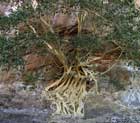
Chris in a big fig Chalcatzingo. This tree appears to be stuck to the rock; there's a seep here and a spring at its base.
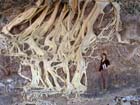
Bonnie and fig roots at Chalcatzingo.
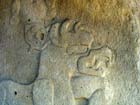
Detail of Monument 31 at Chalcatzingo, which depicts "a large reclining feline crouching on and digging its claws into a prone human" (Cole 2002).
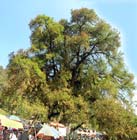
El Ahuehuete in Chalma.

Buses in Chalma are ... different.
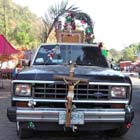
So are pickup trucks.
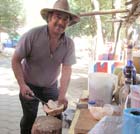
Making Coco Elaborada in Chalma.
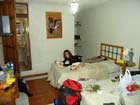
Home is where the pack is.

Conifer-Hunting in Mexico
Day 8: Friday, February 11
We left Cuautla fairly early this morning and headed back eastwards about 20 kilometers to the archeological site at Chalcatzingo, which is an Olmec site that saw peak occupancy ca. 700-500 BC. It lies at the foot of the prominent hills, Cerro Delgado and Cerro Chalcatzingo (exhumed volcanic necks, I suspect) that I saw yesterday afternoon. We arrived before the ruins were open and walked up to the gate, slipped under the barbwire fence and commenced our exploration. Outside the gate were some good metates. Right away, and elsewhere later in the day, we saw large magnificent figs with bright yellow bark and deep green leaves that cling to cliff walls like they were poured on there. They can grow very large, as the photos at Chalcatzingo show.
Archeologically, the site at Chalcatzingo consists mostly of carvings, both of cliff walls and of free-standing stones, and most of the carvings seem to depict people being eaten—the best-preserved is of a person sitting in the mouth of a cave that is also the mouth of a dragon; another shows two people being devoured by jaguars, and a third shows someone being eaten by a crocodile. (Did these folks have some kind of a complex, or was being devoured a common problem back then?) There was also a fine one of a squash plant. Most of them, though, were superficially much deteriorated and are better viewed on the basis of charcoal drawings made from rubbings, which can be seen in the museum below. That museum is brand new (still has cardboard boxes around the edges of the parking area) and contains a few carvings brought down from the site, many small figures and implements discovered during excavations at the site, and one burial with ornamentation. It's a very small museum, only a couple hundred objects at all, with little interpretive commentary and that all in Spanish, although judging from the grammar and vocabulary, fairly scholarly. The museum is kept by an old woman with a speech impediment who was mainly interested in extracting from us more than the 30 peso entrance fee. The site also has a temple complex that is being "restored."
From the site, we drove back through Cuautla and on to Cuernavaca, mostly via the cuota. Along kilometer 5 to 0 before it links up with the main cuota coming S from Mexico City, there are some fine Juniperus flaccida. In Cuernavaca we visited a very upscale supermarket along the Chalma Road. Inside well-dressed Mexican matrons pushed shopping carts along shiny aisles patrolled by armed guards and stocked with pretty much the same type and variety of items you would find in one of the best American supermarkets. We stocked up on imperishable package food, which is otherwise rather hard to come by in Mexico, before heading out towards Chalma.
The road climbs steeply out of Cuernavaca, first through a fine forest with a good bit of Pinus pringlei (our only exposure to this species) and Pinus montezumae, and later and a bit higher through some Abies religiosa and another new species to us, Pinus maximinoi. Eventually the road tops out on a plateau, and up here we found Juniperus flaccida, Pinus leiophylla, Pinus pseudostrobus var. pseudostrobus, Pinus montezumae, and Hesperocyparis lusitanica. We collected some cones and foliage along the way. In Chalma we found an extraordinary Taxodium mucronatum, which the people of Chalma have named El Ahuehuete, "ahuehuete" being the Nahuatl name for Taxodium mucronatum (it means "old man of the water," a fit name for a tree that is always associated with swamps, streams or springs).
Chalma was supposedly visited by Jesus, quite some time ago, and among other things he created a spring that miraculously bursts forth with a flow of about 300-400 liters per second right at the foot of El Ahuehuete. In this happy setting the tree has grown prodigiously; Bob measured it at 580 cm dbh. There is a festival held every Sunday to celebrate this miracle (by Jesus, not the tree), and we walked into the middle of it. All the vehicles were elaborately decorated, with pictures of Jesus and Mary tied to the radiators, fiesta flags and pinwheels wired on all over, elaborate dioramas commemorating the miracle constructed in the beds of pickups, flatbed trucks turned into floats, etc. The market was in full flower and hundreds of people were engaged in a mass baptism at the foot of the tree. Great food was plentiful, including mango-on-a-stick and a drink I will long remember, coco elaborada, prepared by a jolly swarthy fellow in a sombrero. First he whacks the end off a coconut, exposing a 1-3 cm circle of white meat. This he cuts out, and invites you to drink some of the milk. Then he adds two shots of tequila, the juice of 2 limons, a fat pinch of salt and a fatter one of chili powder, and mixes it up. This you drink. Later, you give him your coconut and he cuts it open with one blow of an axe, scoops out the meat with a special tool, and puts it in a plastic bag with the juice of another limon and about 2 tsp of mild chili powder. Shake it up and you have a tasty snack.
About 1630 we tore ourselves away from Chalma and motored down the valley about 10 kilometers to the little town of Malinalco. Malinalco is a moderate town, only about 6000 people, but on the tourist route due to its ruins and its monastery, so it has plenty of good lodging and some good food. It is a typical Mexican town, with stone streets and stone sidewalks and high stone walled compounds with lovely gardens within. We found lodgings (420 pesos for 2 rooms) in the very comfortable hotel El Asoleadero (which I think means "the sunny one"). Bob and I sipped tequila sours while Bonnie frolicked in the pool, and after dark, we wandered down to a lovely restaurant by the town square and enjoyed an excellent meal consisting mostly of things I cannot name and could not recognize. Our eating practice in this country has devolved to one of ordering anything that sounds interesting, because it never fails to be delicious. Afterwards we sipped a little more tequila while a moon holding water shone down over the sandstone canyons lined with dry tropical forest. Then to bed.
Continue to Day 9
go back to "Conifer Hunting in Mexico"









